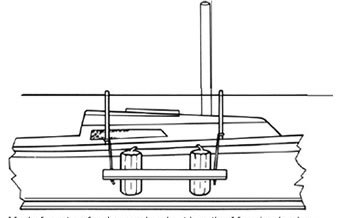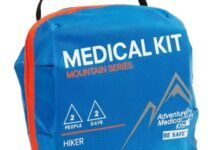My main problem with boat fenders is that they appear to violate the cardinal rule of cruising: any object you bring on the boat should serve at least two purposes (the way your crewmate’s favorite yellow shirt makes a great Q flag). A fender, however, does only one job-cushion the blow between the hull and something hard-and then it swallows up valuable lazarette or anchor locker space when it’s not required.
Recently facing a shortage of fenders, I came upon a temporary substitute—heavy-duty dry bags. Filled with air, these simple roll-top bags work just like inflatable fenders. The main difference is that inflatable PVC fenders like the ones we’ve tested have urethane plastic bladders inside the outer shell (usually PVC), enabling them to hold air longer and be better protected against puncture.
Someone industrious sailor could insert an inflatable urethane liner into a more rugged, welded PVC dry bag, and achieve the same result. The outer bag could be easily fitted with web eyes for securing drop lines. When the dry-bag/fenders aren’t being used dockside, they can keep your off-season clothes dry in the forepeak, safeguard your wardrobe on the Colorado River, carry clean laundry in the dinghy, . . . and so on.
Durability is a question. I’m not sure how long a conventional dry bag will hold up when used as a fender. If they are constructed with a material similar to that used to make the inflatable fenders featured in our recent test, they should last several years if only used occasionally. I wouldn’t be surprised if a non-marine fabricator already sells a thick bag suited for this new purpose. During a recent trip in Idaho, I was impressed by the heavy gauge material used in the dry-bags for whitewater rafters. The ones I saw were made by Jacks Plastic Welding, a custom dry-bag maker located in New Mexico.
So here’s a challenge: Is there perhaps another fender design that could help it serve two distinct purposes? Or are there more uses for a conventional fender than first meet the eye? (I’ve thought of several since first writing this—buoying an anchor for later recovery, keeping chain catenary off a sensitive bottom, rolling a heavy dinghy ashore, etc.).

Jack’s plastic welding in New Mexico, builds a rugged bag for whitewater rafting with handholds that could be used to attach lines in a pinch.
And for those who’d rather just stick with the tried-and-true, here’s a DIY approach to more conventional fenders.
DIY Fender Board
Fender boards are almost a necessity when docking against pilings because without them, no matter how you position and secure your boat and fenders, movement of tide and boat will displace the position of the fenders relative to the piles. The result is dinged topsides. Recently a number of high-density solid foam fenders that work like fender boards have appeared on the market, but I’m not keen to shred foam over the ocean already filled with plastic.
Fender boards, designed to ride outboard of two fenders, provide more durability and protect a much larger section of topsides much more effectively.
The simplest form of fender board is adequate for most needs. All that is needed is a 3- to 4-foot length of 2 x 4, 2x 6, or 2×8. As a guide, I’d start at a 2×4 for a 20-foot boat, 2×6 for a 30-foot boat, and 2×8 for a 40-foot boat.
On a larger boat, you may want to use a slightly longer board, perhaps up to 6 feet long. Anything longer than that, however, is likely to take two people to handle, and be a nuisance to store.
Just go the nearest lumber supplier and get normal dimension lumber, which may be any variety of softwood. Make sure that it doesn’t have any large knots in the middle of the board, which might make it cause it to break under heavy loading. A hardwood like ash will take more abuse, but the extra weight can make it a handful for one person to handle.

A hole slightly larger than the diameter of the suspension or drop lines (say 9/16-inch hole for a half-inch line), is drilled through the larger dimension at either end of the board, about 6 inches from either end.
Next, round the ends of the plank and chamfer all edges. Your lines should be long enough to suspend the plank down to the waterline from whatever stanchions or cleats you plan to use.
After threading the lines through the holes, tie a figure-eight, stopper knot at the bottom of each line, and you’re finished.
Because of the abuse fender boards are intended to take, painting or varnishing them is pretty much a waste of time. And, because you want a fender board to be as gentle as possible to your boat, complications like metal hanging straps or eye bolts are best avoided.
You can us your fender board with conventional round fenders, or you can purchase solid rubber cushions made specifically for attaching to 2×4 or 2×6 spars. Made by Taylor, they are available though most retail chandlers and online. In our experience they do not give the board quite as much standoff from the hull that a large round fender will, but because they are permanently attached to fender board, there is no risk that they will pop out of position, allowing the board to rest- and rub – against the topsides of your board.

The one embellishment you might wish to consider, if you have sufficient time and/or inclination, is a laminated fender board. This board is composed of three layers of 1x 3 fir, hickory, or ash. The layers are not laminated together, but slightly apart, separated by 1/8 strips of wood epoxied in at either end, creating a wooden fender that flexes like a leaf-spring. I saw one of these years ago, and, though I don’t imagine its much more effective than a length of solid 2 x 6, it certainly looked impressive and sowed a certain pride of ownership that a simpler board would lack.
If you find yourself in an exposed seawall, or are expecting a sloppy sea to toss your boat around in the slip, two reports can help ensure your boat emerges unscathed: Fenders and Lines for Seawalls and Spring Lines for Storm Preparedness. To prepare for the tidal surge, storm force winds, and waves that accompany severe weather fronts or tropical storms, our four-volume “Hurricane Preparedness Guide,” digs into details of mooring, anchoring, and docking that other hurricane preparedness guides ignore.






































Great article! Thanks for your guide. These fenders assure ne of my boat’s safety when it’s docked or there are other crafts around me.
While I appreciate the points raised to protect our vessels, I find it interesting that the article starts out encouraging that each piece of gear brought aboard should have at least 2 functions, and then ends with introducing another piece of gear, fender board, with a single function.
A gangway when moored bow or stern to the quay.
Why do the fenders have to go into “valuable” storage space? I just tie them to my davits and stern rail. This lets you keep the more sturdy traditional always-inflated fender that can take the punishment without worry of deflation.
We did our RTW with a 4m long lightweight aluminium ladder that we used as a fender board – worked perfectly and was multifunctional as still served as a ladder. It stored against the stanchions.
Easystow Fenders. Reviewed by PS. Double outer wall with 10 mil urethane liner. Reliable and easy to use. The larger fender works well as a fender board and then deflates for storage. And excellent customer service. A winning product by all measures.
I always applied s. s. rubrail strips to the outside of my fender boards to avoid them wearing down due to chafing at my Miles River Y. C. slip. Also a stain and coat of protectant makes them look Bristol!
Use 5/4 pressure treated lumber (deck planking) for your fenderboards. You’ll get some flex like the fancy laminated one in the article and they are lighter than 2 by lumber. Using pressure treated wood lets you store them outside without damage for many years. Worked great for us.
I made two, but I never used the second one. I think one is all you need.
Inflatable dinghy beach rollers also work great. They serve 2 purposes (if you also ever need a beach roller) and are very, very rugged (made for use on gravel beaches). But, the best part is they are fairly long so no fender board is needed when tied horizontally along the side of your hull.
yes
that is, yes to multiplying uses like fender board for a gangway, and the other good ideas for constructing laminate springy boards, and for other hold-offs besides slippery fenders. I am looking into ideas for a rigid, but rollable foam plank so that we could have it as a long board, or rolled up as a large dia. fender. This is an area for creativity using what you got and what your particular boat can use for dual purpose.
Great idea to use a dry bag as a fender. I wonder if there is a source for suitable sized inserts, though in a pinch cushions or bedding would work. Northwest River Supply is another source of rugged dry bags. DS mentions dinghy beach rollers; I’ve heard good things about the Aere brand and we plan to test them in the NOLS Mexico longboat sailing program this winter. See them here https://duckworks.com/beach-rollers/ and here https://www.youtube.com/watch?v=9yz1nEPA71g
I’m experimenting with a 6′ 2×4 trimmed to work as either fender board or emergency tiller for my NorSea 27, it “should” fit on top of the cabinets in the V berth. I bet in an emergency you would find even more uses for a 2×4 on board. Keep standard cylindrical fenders handy underway to toss in the event of a crew overboard emergency, and of course they work as a “foam roller” replacement to treat aching backs. Here’s to dual duty!
You should always cover your fenders to protect your gel coating from the hot tacky plastic that damages your boat. Maine Coast Marine Products offers custom soft 300 series Polartec fleece that does not retain water.
My experiences with fender boards have been against commercial and industrial bulkheads, where I have actually worn a pressure treated 2×6 to the point of replacement in just a few weeks. While I have seen some fancy boards, durable and easy to replace makes more sense to me for heavy duty use. Likewise, I am leery of fenders that are not extremely abrasion resistant; if the fender gets a flat, my boat may be banging on an unforgiving bulkhead, collecting expensive damage in just minutes.
To me, fenders and boards are like anchoring gear; they can save your boat, and thus are not a place for half measures.
All of this, of course, depends on your sailing area. If you dock in recreational marinas with floating docks, the demands are much less severe.